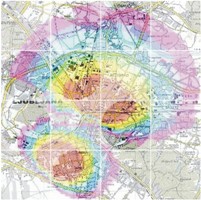COMMUNICATION SYSTEMS – E6
- Telecommunication systems and networks
- Communication protocols, services and applications
- Software tools for testing, modelling and simulation of communication systems
- Radio channel modelling
- Localisation techniques
- Digital twins
- Parallel and distributed systems
- Scientific computing
- Applied scientific computing
- Parallel computing
- Numerical analysis
- Mesh-free methods for numerical solving of systems of partial differential equations
- Computer modelling and simulations
- Wireless sensor networks
- Intelligent Infrastructure Orchestration
- AI supported radio resource management and signal processing
- Anomaly Detection, classification
- Context extraction, Planning and Reasoning
- Cognitive continuum,
- AI and ML for ICT operations
- Smart grids
Departmental web pages
Head of Department
Prof. Mihael Mohorčič, mihael.mohorcic@ijs.si
Telephone: +386 1 477 36 69
Secretary
Polona Anžur, B. Sc., polona.anzur@ijs.si
Telephone: +386 1 477 31 07
Nika Simčič, , B. Sc., nika.simcic@ijs.si
Telephone: +386 1 477 38 70
Research and development activities at the department are carried out in the framework of the Communication Technology Laboratory (CTL), Parallel and Distributed Systems Laboratory (PDSL) and Networked Embedded Systems Laboratory (NESL). The research work of the three laboratories is complementary, which reflects particularly in joint national and international research and applied projects.
The Communication Technology Laboratory conducts advanced research in wireless communication systems, focusing on the integration of intelligence and environmental awareness into modern networks. Our aim is to enhance network adaptability, efficiency, and sustainability while enabling seamless interaction between users, devices, and services. Particular emphasis is given to the solutions providing network robustness, security and quality of services on all layers of the communication system. We advanced deterministic channel modelling for next-generation wireless systems through innovative calibration of ray-tracing tools using custom in-house CSI measurement devices. Numerical and quantum algorithms for propagation analysis are explored, delivering superior accuracy and computational efficiency. In the terahertz domain, we focused on channel characteristics and the applicability of THz waves for integrated sensing and communication (ISAC) systems in future 6G Communication Systems. Due to the complexity of the real telecommunication systems and the dynamic nature of the operating environment, traffic load and users' behaviour, we are also developing suitable simulation and performance evaluation tools for communication procedures, protocols and applications, as well as for planning and dimensioning of telecommunication networks. The laboratory also contributes to advancements in the Internet of Things (IoT), developing energy-efficient localization and phase-based ranging techniques validated in real-world environments.
In the Parallel and Distributed Systems Laboratory, we focus on solving problems that involve computationally intensive problems and problems for which the computation is distributed over heterogeneous computer architectures. To this end, our activities are based on developing algorithms needed in various fields, including numerical simulations, multi-criteria optimizations, analyses of large amounts of data, and graph theory. We advanced local mesh-free methods for solving systems of partial differential equations. Our hp-adaptive solution procedure, based on an iterative solve–estimate–mark–refine paradigm, was formulated and implemented, with its performance demonstrated in numerical experiments. This method advances toward fully autonomous numerical solvers for complex problems in realistic geometries without user intervention. For solidification simulations, we developed a sharp Meshless Interface Tracking (MIT) formulation of the Grain Envelope Model (GEM) for dendritic growth, which offers superior accuracy over prior Phase-Field Interface Capturing (PFIC) methods. In applied research, we maintained and piloted DiTeR dynamic thermal rating software for ELES, and Operato, including system redesigns and deployments for transmission operators.
In the Networked Embedded Systems Laboratory, we are mainly focused on advancing smart infrastructures through innovative signal processing, time series modelling, and AI-driven decision-making, including representation learning, deep learning, clustering, and classification. This enhances accessibility, usability, and efficiency in networked embedded systems. In anomaly detection for large-scale IoT (e.g., smart factories/cities), we developed an AI-based extraction module for digital twin monitoring. It processes signal data to detect and characterize different abrupt received signal strength anomalies, maintains historical logs, and triggers automated mitigations. In spectrum sensing, we explored label-free RAT classification and introduced a new workflow designed for realistic, unlabelled setups that can be easily transferred across environments. We are conducting research on MLOps pipelines and comprehensive ML development workflows to enhance the automation and reliability of model deployment. In smart infrastructure research and development, we are focusing on automatic classification of time series data, using shallow and deep machine learning methods for appliance classification in smart grids. For energy management, we introduced CARMEL, a novel deep learning approach that enhances non-intrusive load monitoring through efficient spatio-temporal data representation and multi-label classification. In Addition, a synthetic-data evaluation framework mimicking real scenarios were introduced.Networked Embedded Systems Laboratory and its research activities also form part of the interdepartmental laboratory SensorLab, established together with the Laboratory of Artificial Intelligence (E3).
